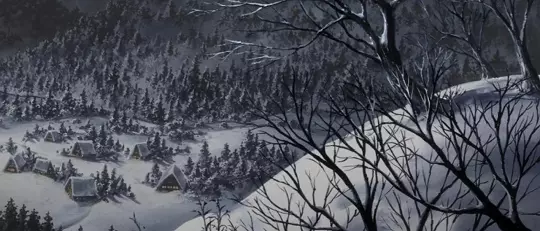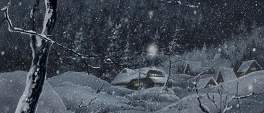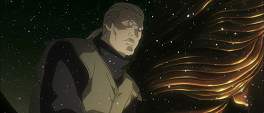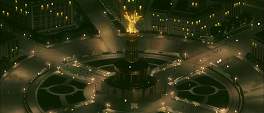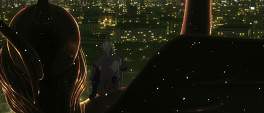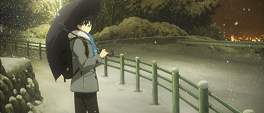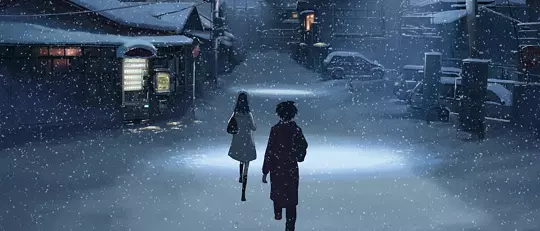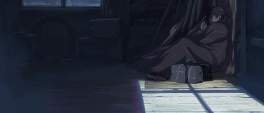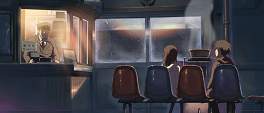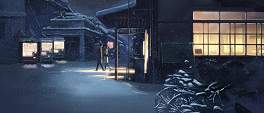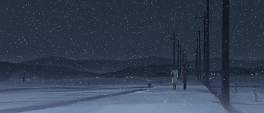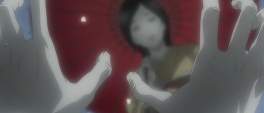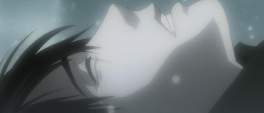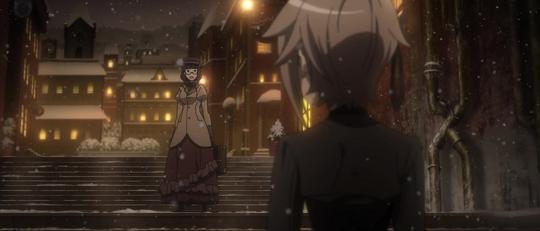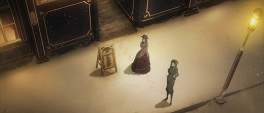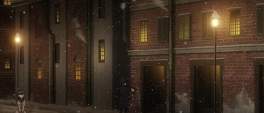I spent a large part of my childhood in the north eastern part of Scotland which, to those who aren't familiar with the area would describe as “the middle of nowhere”. Those who are would likely nod and then call it something much worse. Summers were short and hot, the hills abundant and green and the winters biting and long. Water pipes froze, roads closed, and snow drifts towered over children sledging carelessly into them.
It has a romantic appeal, being snowed in snug and warm beneath a blanket next to a crackling fire, until you actually want to do something productive like eat or travel anywhere. That child-like nostalgia persists however, so whenever a video game or anime does winter, I’m always searching for that ephemeral feeling that only a quiet, snowy vista can elicit.
Just having a good scene set during winter though doesn’t automatically make it a good winter scene - Guts versus Griffith (part two) takes place on a crisp, white morning and it’s understandably evocative, but doesn’t tickle memories of the past. Similarly neither does just setting a scene, or even your entire series, during winter - so Non Non Biyori, WWW.Working!! (the northern one), Noragami and Primsa Illya 3rei all feel frosty but don’t make the grade. And just faking winter snow is cheating, yes I’m looking at you Nagi no Asukara, salt flakes doesn’t count.
So to lead be example, here are six perfect winter scenes in anime.
Mushishi
You really are spoiled for choice with Mushishi when it comes to winter scenery. Whether it’s episode fifteen of season one, “Pretense of Spring”, or take your pick from season two with episode three’s “Beneath the Snow” or episode nine’s “Valley of the Welling Tides”. My choice though is episode three from season one, “Tender Horns”. The Mushishi anime already embraces a lot of what makes a great winter scene, so when Ginko approaches a village deep in the mountains, where even the wind cannot reach, snow drifting noiselessly down from a dark sky and Toshio Masuda’s “Yawarakai Kaku” (柔らかい角) plays as feet crunch through the snow, its effect is magical. “Beneath the Snow” from season two follows a similar pattern with the new opening, Lucy Rose’s “Shiver” setting the perfect tone, but that episode has a much darker tone to it, teetering on the edge of horror at times. For audio use alone though, Mushishi’s winter scenes are consistently, spine-tinglingly spectacular.
Ghost in the Shell: Standalone Complex: 2nd GIG
For a series so brutally futuristic taking place almost exclusively in the shadows of sleek high-rises and the warrens of mega cities, it would seem an odd for such a peaceful winter scene to exist. Indeed, it takes Section 9 visiting Europe, Berlin specifically, before the quiet brilliance of episode eighteen, “TRANS PARENT”, shines through. Kusanagi and Batou are on a long term surveillance operation, stuck in the winter twilight between gabled buildings with honeyed light flowing out of frosted windows as errant flakes of the season’s first snow drift down. An inky green night comes and Batou looks across the city from his vantage point atop Heinrich Strack’s Victory Column, wrapped in a long coat to keep out the fell wind blowing across the cityscape as Yoko Kanno’s silky smooth “Europe” plays. It’s achingly evocative and only bolstered by the following scene of a clear, blue morning in a park as people pass by in all their winter finery.
Kara no Kyoukai
It’s no secret that I'm a huge fan of the anime adaptation of Kinoko Nasu’s debut work, and much like Mushishi, Kara No Kyoukai in many ways embodies that ephemeral, intangible wintry feeling throughout, but no more so than the opening of the second movie, Satsujin Kosatsu - Zen (A Study in Murder Pt. 1). Barely two minutes long, the scene precedes even the movie’s title card and sees a young Kokuto trudging up a hill on the outskirts of the city, heavy snow piling on his umbrella. He stops as he spots a girl looking out across the glowing buildings and houses spread out below. Only the distant, muted murmur of the city can be heard. The girl, dressed in a pure white kimono with a bright red haneri turns and looks at him, before smiling evanescently. Yuki Kajiura’s lonely piano melody plays out Kokuto and Shiki’s first meeting. It remains one of my favourite openings to any medium - film, anime, TV or otherwise - for its simplicity, its beauty and for capturing the light and sound that suffuses a city under snow.
Five Centimeters Per Second
Anything with Makoto Shinkai in a directorship position is going to be visually stunning, and by the time Five Centimeters Per Second (Byousoku 5 Centimeter) had been released, his artistic credentials were well established. With the entirety of the first story in this three story compendium set during a particularly vicious snowstorm, there are a lot of scenes that ache of winter. While the two protagonist’s farewell on the empty train platform that closes out the story is personally very dear to me, the best scene is the couple’s journey from the station the night before. Winter has been the antagonist of the piece up to this point, delaying and frustrating Takaki on his journey until, swathed in the great swell of Tenmon’s score, he finally meets up with Akari in a lonely, rural station. What follows is the slow, tender dawning of their situation, both present and future, and as they wander from the warm light of the station into the vast, frozen night the realisation for both of them, like the snow settling, begins to sink in. Just as Kara No Kyoukai captured a luminous winter city, here Five Centimeters Per Second does with the endless silence of the countryside.
Blue Literature (Aoi Bungaku)
A compendium of six adaptations of well known literary works, Osamu Dazai’s “No Longer Human” is the first and longest story in Aoi Bungaku’s run and tells the story of the deeply troubled Oba Youzou. He is ostracised from his family and indulges in a life of hedonism replete with adultery, alcohol and duplicity. His lowest point comes in the third episode as he drunkenly stumbles around a city on the brink of war and already buried under snow, before collapsing on the street letting the misty white landscape consume him. A traditional red umbrella appears over him, and thus begins his relationship with Yoshiko, a forthright and practical young woman. Whereas other scenes in this list epitomise the experience of winter, this one uses the season and the weather to mirror the protagonist’s mindeset; barren and bleak, the juxtaposition of Yoshiko’s blood red kimono and umbrella against the sterile white, signals when Oba begins to find some peace, for a time at least. Much of the last two episodes of “No Longer Human” take place during winter and are bitter, blue and frigid, but it’s the trundling of a snow-capped street car and the rapidly dwindling visibility that really makes it a special scene.
Princess Principal
The episode that really kicked off the thinking for this list is Princess Principal’s tenth, “Case 22, Comfort Comrade”. Cheating perhaps to have yet another Yuki Kajiura score on here, but the series does something different to the others by being set in a steampunk vision of Victorian or Edwardian London replete with teenage girls running around as spies. Trussed up in frilly dresses and wrapped in wooly coats to ward against the gloaming snow showers they chase down a defector, dashing through amber hued streets, down icy steps and into regal looking houses before a thrilling chase and showdown on a smoke belching train. Soft lights, copper tankards and wood panelling strike right at the heart of a romantic winter setting and the episode balances running gun battles with sombre, lonely drama. The series' final two episodes echo the same kind of sentiment with sedition and regicide replacing defection and betrayal but opt for bombast over quiet loneliness, so still capturing that wonderful winter landscape but without the feeling to accompany it.
--
It seems all it takes to create a wonderful winter scene in anime then is a guy, a girl, snow, some piano music, solitude and a deep existential longing. This is by no means an exhaustive or even a “best of” list for brilliant winter scenes in anime so if you can think of any more, let me know on Twitter. Except if you’re going to say Tokyo Ghoul Root A’s ending in which case just keep it to yourself. Some of the anime that I considered but for one reason or another didn’t make the list: Gunslinger Girl (original series), Black Lagoon (Second Barrage, Japan), Erased, Cowboy Bebop (Jupiter Jazz episodes), Tokyo Godfathers, Seirei no Moribito, From the New World amongst many others.

